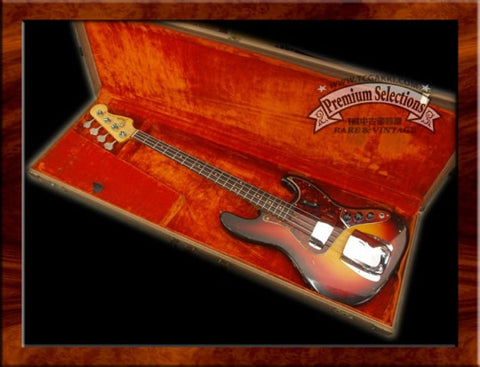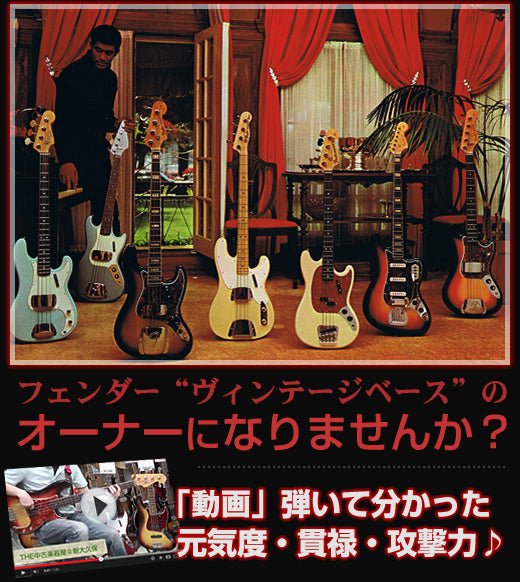
Engagement rings are often said to be worth 3 months salary!
Fender's current lineup, the Vintage Series, was born in 1982, and in order to restore the prestige of the Fender brand by going back to its roots, the company's management turned its attention to the legacy of the company's glorious history. Instead of mass-production profitability, the quality of the '60s was reevaluated, and here Fender's original and reissue models came into existence.
The status of "Vintage" was established, and as with acoustic instruments, the more rare they became, the higher the price in the market became.
Even at the time of its initial release in the 1960s, the bass guitar cost $199.50 and the Bassman amp $203.50, or about 70,000 Japanese yen (1$=360 yen at the time). In the same year, a small refrigerator (90L) for general household use went on sale in Japan for about 80,000 yen, equivalent to 10 months salary of an office worker.
There was also the promised price of an engagement ring equivalent to three months' monthly salary, but even compared to a refrigerator, which is also one of the three sacred instruments, it is understandable that this instrument is far from being a one-citizen instrument. In Japan, such circumstances led to the production of many copy models. It took about 20 years from the release of the original until the quality of the original was equaled, and Fender Japan was established in 1982 with the intention of clearly differentiating Fender's original from the many copy models.
We call the basses manufactured in Japan at this time "Fender Japan".Samurai BassWe call them "Samurai Basses".
Fender Golden Sixties
Fender made a great leap forward in the 1960s, and in 1952, Music Trade Magazine published an article about Fender's Precision Bass. The title of the article was "Portable String Bass," and it described the bass as being louder than a wood bass, easy to carry, and less tiring.
An improved version of the Precision Bass was added to the lineup in 1960.

1960 catalogue
The NAMM Daily dated July 12, 1960, introduces the new product as follows
"Fender introduces the newly developed Jazz Bass, with two pickups and new circuitry for a richer bass range,
The neck is thinner than the Precision Bass, allowing for more flexible control of the high frequencies."
Developed in the United States around the 1900s, Blues evolved from the musical conversations between musicians that took place within it, creating the Jazz form. Evolution and maturation progressed further, and by the 1960s, a rough approximation of the music is already complete today.
The fusion of European and African music to create a new form is the reason why Jazz and Bleus have developed on a global scale.
In the 1960s, musical instruments were further electrified and musical styles changed drastically.
Fender, founded in 1945, followed the electric guitar with the introduction of the electric bass in 1951. In the Jazz scene of the 1950s and 1960s, the double bass was the mainstream instrument, but in the Blues and the new Rock scene, the role of the bass was changing as the volume of the instrument was increasing. The role of the bass also changed. The lineup of bass instruments expanded along with the change in musical forms, and finally in 1960, the Fender Jazz Bass was born.
Specifications and sound by model and year
1961 Jazz Bass Stack Knob

|
P/U resistance value: |
F 6.96kΩ / R 7.55kΩ |
|
Blissful sensation: |
☆☆☆☆☆ |
|
Temptation Degree: |
☆☆☆☆☆ |
|
Money: |
☆☆☆☆☆ |
1961 Jazz Bass Stack Knob
1961 PRECISION BASS SLAB BOARD

|
P/U resistance value |
11.15kΩ |
|
Destructive force: |
☆☆☆☆☆ |
|
Expectancy: |
☆☆☆☆☆ |
|
Like Button: |
☆☆☆☆☆ |

Start distributing color charts in the Fender Sales Department.
1962 Jazz Bass

|
Changed from 2Vol/2Tone to 2Vol/1Tone. |
|
|
Aftertaste: |
☆☆☆☆ |
|
Dignity: |
☆☆☆☆☆ |
|
Cutting edge: |
☆☆☆☆ |
1962 PRECISION BASS SLAB BOARD

|
The following year, '63, the fingerboard laminate was changed from slab (flat) to round. |
|
|
P/U resistance value: |
11.09kΩ |
|
Facial color: |
☆☆☆☆☆ |
|
Coc: |
☆☆☆☆ |
|
Taste: |
☆☆☆☆ |
1962 PRECISION BASS SLAB BOARD

1962-63 fender catalogue
1963 Precision Bass

|
Neck plate serial numbers start with L |
|
|
P/U resistance value: |
11.38 kΩ |
|
Reliability: |
☆☆☆☆☆ |
|
Workmanship: |
☆☆☆☆ |
|
Physical condition: |
☆☆☆☆☆ |
1963 BASS VI

|
The Bass VI lineup in 1961, which was favored by studio musicians of the time and whose sound would be etched on several famous recordings. |
|
|
Two sides: |
☆☆☆☆☆ |
|
Popular: |
☆☆☆☆ |
|
New sensation: |
☆☆☆☆ |

1963-64 fender catalogue
1964 Jazz Bass

|
The "OFFSET Contour Body" logo decal on the Jazz Bass was moved to the top of the head. The position mark was changed from clay dot to pearloid, the Precision Bass logo was changed to transition logo, the pickup bobbin was changed from black to gray, and the enamel wire was changed from dark brown to orange. |
|
|
Partnering degree: |
☆☆☆☆ |
|
Degree of Affinity: |
☆☆☆☆ |
|
Livelihood: |
☆☆☆☆ |

1964-65 fender catalogue
1965 Jazz Bass CAR

|
Fender sold to CBS |
|
|
P/U resistance value: |
F 3.52kΩ / R 3.52kΩ |
|
Fashionable: |
☆☆☆☆☆ |
|
Attention: |
☆☆☆☆☆ |
|
Offensive: |
☆☆☆☆ |
1965 Jazz Bass CAR
1966 Jazz Bass

|
The model on the left is still in the dot position, but the binding on the neck is starting to be added, and the block position is also added. Around the middle of this year, medium jumbo frets and pegs were produced in-house. Clover and paddle type pegs are used, and reverse winding is discontinued. Coronado basses and Mustang basses are added to the lineup. |
|
|
P/U resistance: |
F 4.24kΩ / R 3.33kΩ |
|
Clearness: |
☆☆☆☆☆ |
|
Reassuring: |
☆☆☆☆☆ |
|
Minor changes: |
☆☆☆☆☆ |
1966 Jazz Bass
1966 MUSTANG BASS

|
The first bass to adopt the oversize logo (CBS logo), this 30-inch neck scale bass was marketed to children and beginners and quickly penetrated the market. |
|
|
Charm: |
☆☆☆☆☆ |
|
Vigor: |
☆☆☆☆☆ |
|
Weight: |
☆ |

1965-66 fender catalogue
1967 Coronado Bass II

|
The production period was only about 2 years from 1967 to 1969. |
|
|
Isolation: |
☆☆☆☆ |
|
Cowboy: |
☆☆☆☆☆ |
|
Physique: |
☆☆ |
1968 TELECASTER BASS

|
Its deep sound was not well received when it was released in 1951, and over time, in 1968, it was released with almost the same specifications as the original 1951 Precision Bass. |
|
|
Love at first sight: |
☆☆☆☆☆ |
|
Masculinity: |
☆☆☆☆ |
|
Astringency: |
☆☆☆☆☆ |


1968 Catalog
1969 Jazz Bass

|
Transition logo changed to CBS logo. |
|
|
P/U resistance value: |
F 3.70kΩ / R 3.75kΩ |
|
To be protected: |
☆☆☆☆☆ |
|
Boxed degree: |
☆☆☆☆☆ |
|
Style: |
☆☆☆☆☆ |
1969 Jazz Bass


1969 Bass Catalog
2006 Fender Custom Shop

|
MBS 60 Jazz Bass NOS Masterbuilt by Dennis Galuszka |
|
|
P/U resistance value: |
F 3.72kΩ / R 3.75kΩ |
|
Color Whiteness: |
☆☆☆☆☆ |
|
Workmanship: |
☆☆☆☆ |
|
Freshness: |
☆☆☆☆ |
2006 Fender Custom Shop
Dennis Galutka joined Fender's Custom Shop in 1999, not only as a player, but also because of his passion for making instruments. He has been a drummer and bass player for many years, and his bass production has been analyzed from a bass-playing perspective, and his reputation has grown worldwide.
Guitar Play: Tsukasa Takahashi
It is not expensive to buy a dream!

In the 60's and 70's, the sound was universal and never influenced by trends. It is no exaggeration to say that the sound of the 60's and 70's was the origin of the electric bass sound for electric bands, and most of the modern music was already established in the 60's. The albums from those days are still selling well, and the music of the 70's is still popular. This is evidenced by the fact that albums from that era are still selling well and gaining new fans. The models used by musicians of that era ...... and colors. It doesn't mean the same sound, but the atmosphere ...... and status.

In those days, the starting salary for a salaried worker was about 30,000 yen, and a trip from Shinjuku to Harajuku on the Yamanote Line cost 10 yen, and a bowl of ramen was 35 yen.
The sound, texture, and smell that only instruments made in those days have, add to the value of a Vintage instrument.

To be a Vintage owner is not only to own an instrument, but also to have the space of that time. For bass players, it is a luxurious "supreme status". Why don't you make the purchase of a lifetime?

